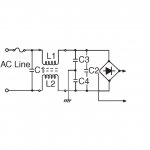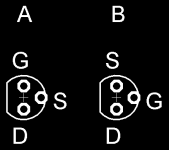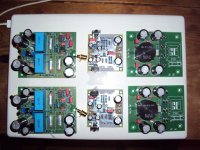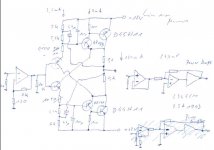Do you think about something like that : PLK1182-ND ( Digikey ).
I made good experiences with common mode chokes too on the DC side.
Looking at post 16 again i think it is better to raise R4, R15 to 300 Ohm. That lessens the noise contribution of the second stage, drives the second stage more into class A and gives a slight open loop gain increase.
I made good experiences with common mode chokes too on the DC side.
Looking at post 16 again i think it is better to raise R4, R15 to 300 Ohm. That lessens the noise contribution of the second stage, drives the second stage more into class A and gives a slight open loop gain increase.
Do you think about something like that : PLK1182-ND ( Digikey ).
I made good experiences with common mode chokes too on the DC side.
Looking at post 16 again i think it is better to raise R4, R15 to 300 Ohm. That lessens the noise contribution of the second stage, drives the second stage more into class A and gives a slight open loop gain increase.
Yes, but horizontal types are better when you have enaugh space to mount them-less radiated noise.It is very strange why CM chokes are so rare as filtering component in linear P.S.
Could you give me a hint what choke you prefer ?
Here is an interesting parer about noise suppression :
http://industrial.panasonic.com/ww/i_e/00000/noise_e/noise_e/technical/TT0001_e.pdf
Here is an interesting parer about noise suppression :
http://industrial.panasonic.com/ww/i_e/00000/noise_e/noise_e/technical/TT0001_e.pdf
I am using CM chokes similar to Digikey distributed Panasonic series 4oo types.Could you give me a hint what choke you prefer ?
Here is an interesting parer about noise suppression :
http://industrial.panasonic.com/ww/i_e/00000/noise_e/noise_e/technical/TT0001_e.pdf
They are 0.8A 68mH. If they are good enaugh for 300000$ Blowtorch or 4000$ Parasound Jc-2.......
Last edited:
It is not Blowtorch power supply, it has never been published. Presented circuit was posted a long time ago by a French guy who was trying hard to guess Mr. Curl designs. All we have is detailed Mr. Curl description from which we see that he uses two rec. bridge approach , CM choke in the same way as you did in your PS. Unlike Frenchman, he uses adj. regulators in textbook manner, and furher down series resistor and simple open-loop shunt regulator of unknown topology, not IC referenced one.I found a simplified schematic of the Blowtorch PSU. JC seems to use the common mode chokes just like me.
Near the circuit, there are cap. multipliers , he said with 1A Harris Mosfets.
I got a visit from Klangmeister Georg Stracke and we listened to his Nobrainer. He had build the original version that Holger had layed out with servo and LT1028. Martina Schöner was also there on her way back from Vienna. It sounded so good that i decided not to design a fully discrete version any more but max out the original circuit. I will make a double mono PSU and Georg will lay out the boards. Each channel has to fit on half a Euro board.
Georg is now working on a layout :Das Leben des Klangmeisters » “Nobrainer”- Phono-Stufe von Joachim Gerhard …Update…
I designed a PSU that should work really well.
I designed a PSU that should work really well.
I have good news. PCBs for the Nobrainer are now available. All is modular and Mono so we have a Phono Board, the Shunt Regulator and the Pre-Regulator. I will publish some pictures and more information soon. The boards have being layed out by Klangmeister Georg Stracke and manufactured by Fischer in Germany. The quality is FR4, 2-layer with position print. From 100 pieces prices are competitive.
Holger Barske played a solar panel driven system on the Frickelfest. I contributed with my build of the Nobrainer that draws not more then 50 mA, both channels driven.
I also gave Holger the grand father of the high speed preamp, described on MPP, but unfortunately there was a short in the P-P build and i was too occupied to repair it, so he played a passive preamp. The power amp was a switched mode thing that did not sound fully satisfying. On the other hand i think a solar driven system is a good idea so Holger asked me if i can design a power amp that works on plus-minus 12V and does not draw too much power.
I had a little time today and came up with a possible solution. Some time ago there was a little thread about Diamond-Sziklai Power Buffers. I found a circuit by Lineup that is a further development of a PMA buffer that i like. The only thing i did is lowering the idle to 120mA and re dimensioning the circuit to smaller output transistors and lower voltage. 120mA and around 24,5mV over the output resistors is a good compromise when we want to avoid class-A that is out of the question because of efficiency. We need voltage gain of cause so i added an Opamp. The buffer works open loop here.
Another option is to put the buffer in an inverted loop and add a buffer at the input.
This is a bit more complex but lower in static distortion.
Some time ago i build a headphone amp that way that sounded good.
I also gave Holger the grand father of the high speed preamp, described on MPP, but unfortunately there was a short in the P-P build and i was too occupied to repair it, so he played a passive preamp. The power amp was a switched mode thing that did not sound fully satisfying. On the other hand i think a solar driven system is a good idea so Holger asked me if i can design a power amp that works on plus-minus 12V and does not draw too much power.
I had a little time today and came up with a possible solution. Some time ago there was a little thread about Diamond-Sziklai Power Buffers. I found a circuit by Lineup that is a further development of a PMA buffer that i like. The only thing i did is lowering the idle to 120mA and re dimensioning the circuit to smaller output transistors and lower voltage. 120mA and around 24,5mV over the output resistors is a good compromise when we want to avoid class-A that is out of the question because of efficiency. We need voltage gain of cause so i added an Opamp. The buffer works open loop here.
Another option is to put the buffer in an inverted loop and add a buffer at the input.
This is a bit more complex but lower in static distortion.
Some time ago i build a headphone amp that way that sounded good.
- Status
- This old topic is closed. If you want to reopen this topic, contact a moderator using the "Report Post" button.
- Home
- Source & Line
- Analogue Source
- JG´s Nobrainer and Nobrainer Discrete



